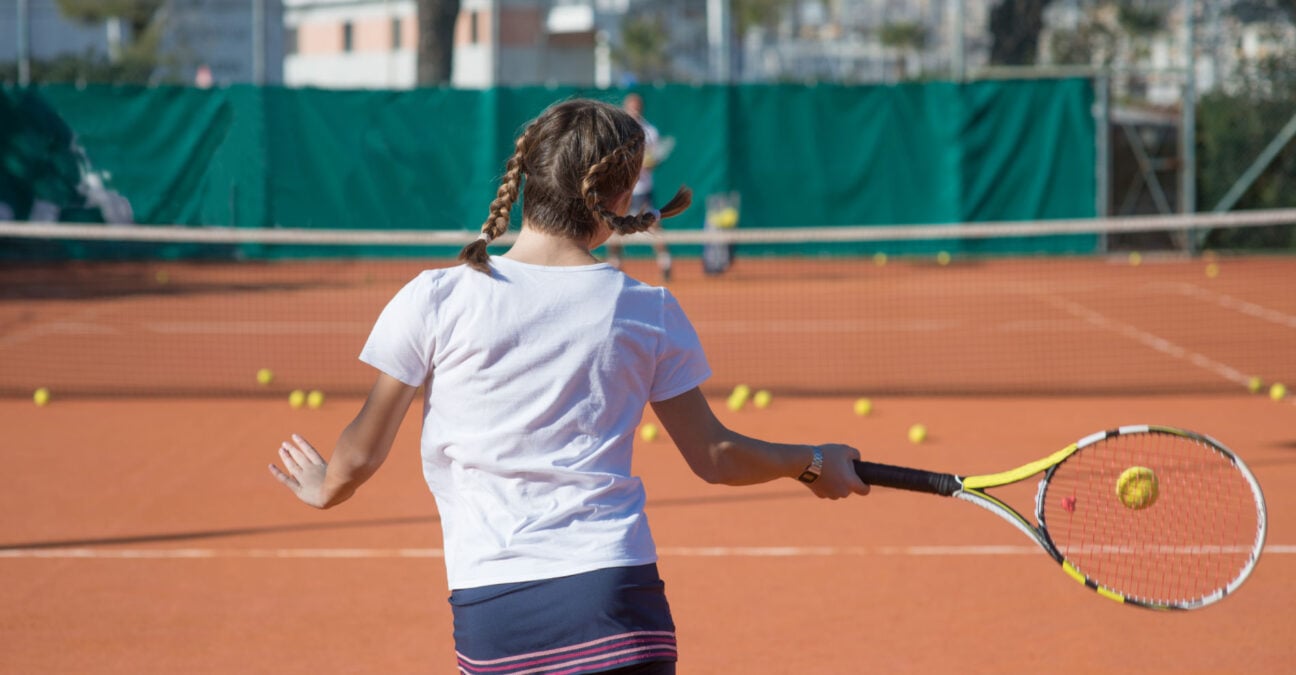Tennis Scholarships Guide: Recruited & Fund Education
Discover how to earn a tennis scholarship, get noticed by coaches, and secure funding. This friendly guide offers key steps and tips for your tennis journey
 Tennis school – © shutterstock
Tennis school – © shutterstock
Many students search for reliable support when navigating the scholarship process. For student-athletes, the challenge often goes beyond perfecting their serve or maintaining tournament rankings — it’s also about managing coursework under pressure. Those pursuing rigorous academic paths, such as nursing, may need extra help balancing classes and training. In such cases, a nursing paper writing service can provide essential support, helping athletes stay on track academically without sacrificing performance on the court.
Tennis scholarships can open doors to universities that reshape a student’s entire future. While the process may seem overwhelming at first, clear guidance can break it down into practical steps. Understanding how scholarships work, what coaches look for, and how to build a compelling profile is key. Success requires not only athletic talent but also academic readiness, communication, and persistence. The sections below walk you through the strategies that can help you secure funding while keeping your goals on and off the court in focus.
Tennis Scholarships
A tennis grant is money set aside to reduce tuition and required fees for athletes. Packages vary from small help to full costs, depending on program resources and player quality. Many American campuses provide these awards to competitors who excel both on the court and in the classroom. Coaches decide allocation sizes after measuring talent, growth potential, and team needs. Some families assume few opportunities exist, yet dozens of conferences distribute strong support yearly. A standout report card often improves the final offer, because higher grades raise a roster’s academic average. Start research during your sophomore or junior year to track application timelines comfortably. Early awareness allows athletes to match their ability with programs sporting similar expectations. Compare scholarship limits, coaching style, and travel schedules when building a shortlist. With accurate facts, families avoid wasted applications and focus energy on realistic choices.
The Recruiting Process
Recruiting begins when a player showcases prime skills through competition and clear communication. College staff search for individuals who strengthen lineups while upholding academic benchmarks. Exam numbers, class rank, and personal drive carry weight equal to forehand power. Dedication should start before senior year, because habits form early and impress evaluators. A busy calendar of sanctioned events boosts ranking points and sharpens match instincts. Large tournaments attract many scouts, offering valuable exposure within a single weekend. When interested, a coach might send messages, schedule calls, or invite an unofficial visit. Continuous conversation clarifies training style, scholarship range, and campus culture. Each university follows unique timelines, so flexibility remains essential throughout negotiations. The stage concludes when an athlete signs a commitment letter reserving their roster spot. Before signing, recruits often compare medical support, academic resources, and travel commitments offered by each program. Talking with current players gives honest insight about daily schedules and team expectations.
Requirements and Eligibility
Eligibility rules vary between collegiate divisions and governing bodies. The NCAA monitors Division I and Division II programs through academic and amateur guidelines. Minimum core course averages and standardized test thresholds must be satisfied to enter those rosters. The NAIA designs its own framework, yet still values grade strength and a complete curriculum. Prospects should review official rule pages early to confirm compliance and prevent frantic changes later. Beyond classroom numbers, coaches study performance indicators like Universal Tennis Rating, International Tennis Federation points, or regional lists. Tournament resumes reveal toughness, focus, and adaptability during tight sets. International applicants may face extra steps related to language exams, visas, and insurance. Each university also posts separate deadlines for transcripts, medical forms, and admission tests. Building a checklist of tasks helps families manage paperwork without overlooking details. Coaches appreciate recruits who respect timelines and arrive prepared, because it shows maturity. Maintaining updated copies of scores and ranking proofs ensures quick responses when staff request evidence. Such an organization can separate one candidate from another when scholarships become scarce.
Building Your Tennis Resume
A polished tennis resume acts as a snapshot of skill, growth, and determination. Tournament victories, ranking milestones, and sportsmanship awards deserve clear placement near the top. High-definition match clips reveal footwork, shot selection, and mental strength under pressure. Coaches often prefer condensed highlights lasting three to five minutes rather than entire sets. Include brief context describing event level, opponent ranking, and final scores for each featured rally. Letters from trusted mentors can confirm practice habits, leadership, and character. Keep statements honest because staff verify statistics through governing bodies and public records. Add a concise paragraph outlining academic interests and long-term ambitions to show balance. Format should remain clean, using headings, bold type, and readable spacing. Treat the document like a job application where first impressions influence serious investment. Update the file every season to capture fresh achievements and remove outdated numbers. Including volunteer service or club leadership can highlight maturity beyond athletics. Save the resume as a PDF to protect formatting when emailing multiple institutions. Always rename the file with your full name and graduation year, making retrieval easy for staff.
Connecting with Coaches
Initial outreach often begins with a short email that introduces the athlete and links to highlight footage. The subject line should include name, graduation year, and recent ranking to grab attention quickly. Inside the note, list key statistics like height, dominant hand, and Universal Tennis Rating. Mention upcoming tournaments where the coach might watch in person. Respectful persistence matters; follow up after two weeks if no reply arrives. When a coach responds, ask about scholarship availability, training philosophy, and academic support systems. Speak clearly during phone calls, and prepare questions about housing, travel budgets, and seasonal goals. Parents can listen quietly but let the student handle most dialogue to show independence. Campus visits provide chances to observe practice sessions, tour facilities, and meet teammates. After leaving, send a thank-you message reaffirming interest and summarizing mutual next steps. Keep a spreadsheet recording contact dates, responses, and action items to stay organized. Such tracking prevents missed deadlines and shows a professional manner during conversations. Consistent courtesy builds trust, which often influences final scholarship decisions.
Financial Planning
Even generous awards rarely cover every expense linked to higher education. Tuition may be paid, while meals, books, and travel remain partly uncovered. Families should estimate total yearly costs by reviewing university budgets and personal spending habits. Financial aid offices provide information on grants, need-based funds, and work-study programs that bridge gaps. Compare loan terms carefully, focusing on interest rates and repayment schedules after graduation. Some teams divide scholarships among several players, so percentage shares fluctuate annually. Performance improvements can raise funding, whereas dips in form may reduce support. Discuss these conditions with coaches before signing any agreement to avoid surprise changes. Include hidden charges like lab fees, parking permits, and mandatory insurance in planning sheets. Building a realistic budget lowers stress, allowing athletes to concentrate on training and coursework. Parents might open education savings accounts early to lessen future loan dependence. Seasonal employment during summer can create extra reserves for supplies and social activities. Wise financial habits learned now support security long after the last match.
Academic Considerations
Academic health stands equal to athletic skill in the scholarship equation. Universities lose points if athletes become ineligible, so coaches favour consistent scholars. Falling grades can reduce or cancel financial aid, placing extra strain on families. Recruits should build study routines that travel well during busy tournament swings. Many campuses provide free tutoring, writing centers, and learning strategy workshops. Student-athletes often choose majors that interest them while fitting practice timetables. Advisors help craft balanced schedules combining lectures, laboratories, and recovery periods. Some institutions permit stacking academic grants with tennis awards, easing budget pressure. Strong classroom results also impress future employers who value discipline and teamwork. Maintaining a high grade point average protects eligibility and preserves long-term scholarship security. Planning ahead for exam dates prevents clashes with conference championships or postseason events. Online course options can offer flexibility without lowering academic standards. Athletes who master time management find more energy for both studies and training. Such balance highlights maturity, a trait coaches cite when renewing yearly awards.
Life on a Tennis Scholarship
Campus life for scholarship athletes blends rigorous practice with ordinary student duties. Most teams schedule morning conditioning followed by classes, afternoon drills, and evening study sessions. Travel days stretch long, especially when flights and ground transfers sandwich important matches. Managing coursework during road trips demands careful planning and early communication with professors. Many athletic departments offer mobile study labs, tutors, and advisors who travel with squads. Coaches monitor fitness levels, diet logs, and recovery routines to avoid injuries. Team rules often cover curfews, social media conduct, and classroom attendance. Friendships within the roster form quickly, creating a support network that eases pressure. Weekends may include doubleheaders, leaving little leisure time until off-season breaks. Players build endurance through tight schedules, delayed flights, and demanding opponents. Good habits gained here translate to future jobs requiring discipline and leadership. Even with challenges, many athletes view scholarship life as an unforgettable chapter filled with growth. Regular check-ins with academic advisors ensure continued eligibility and steady progress toward a degree. Community service projects arranged by athletic staff strengthen ties between teams and local supporters. Off-season months still involve weight training, league play, and skill refinement to maintain a competitive edge.
Conclusion
Securing a tennis scholarship demands equal parts athletic excellence and academic dedication. Understanding governing rules, crafting a strong resume, and communicating clearly with coaches guide the process. Financial relief gained from these awards grants access to quality education and memorable competition. Players who refine skills, maintain grades, and demonstrate integrity improve their chances greatly. Families should outline budgets and backup aid to handle remaining expenses responsibly. Long-term planning, including balanced course loads and recovery schedules, protects both body and mind. Scholarships reward not only winning records but teamwork, leadership, and steady character. By using club networks, online tools, and tournament exposure, athletes locate programs that fit their goals. With patience and steady effort, a young player can join a roster and complete a degree. Those achievements lay the foundation for a promising future beyond the baseline.











